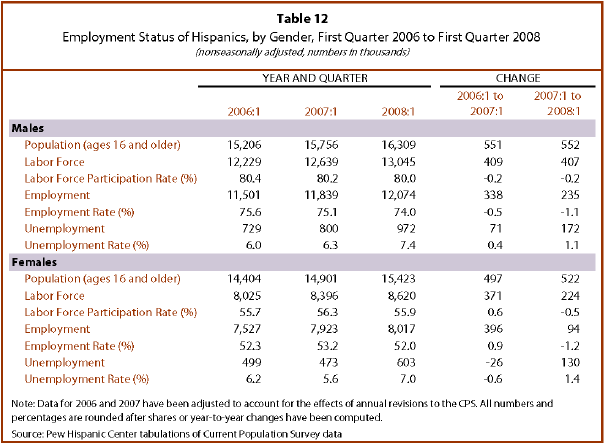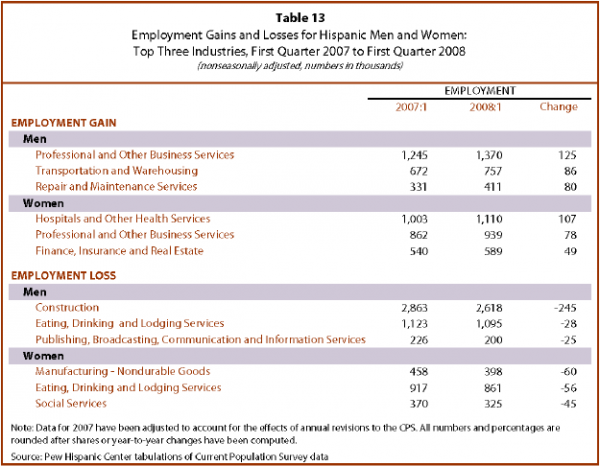Although the construction industry, a mainstay for Hispanic men, is one the leading causes of the current economic slowdown, Latino women are not immune from the effects of the slowdown. In some respects, outcomes for Latino women appear worse than those for men. They left the labor force in greater proportion and experienced greater increases in unemployment than men. While the construction sector was not a factor in job losses for Latino women, they lost jobs in manufacturing, eating, drinking and lodging services, and social services.
The Latino working-age population included 15.4 million women in the first quarter of 2008, or 48.6% of the total (Table 12). But Latino women are much less likely than men to be active in the labor market. Only 55.9% of women participated in the labor force in the first quarter of 2008, compared with 80.0% of men. Thus, women accounted for only 39.8% of the Latino labor force in early 2008—8.6 million compared with 13.0 million Latino men.15
Given the weaker attachment of Latino women to the labor force, it is perhaps not surprising that they withdrew from the labor force in somewhat greater proportion than men in response to the economic slowdown. Labor force participation among Hispanic men changed little. They added 409,000 workers to the labor force in 2006, an increase of 3.3%, and 407,000 workers in 2007, an increase of 3.2%.
But Latino women added only 224,000 workers to the labor force in 2007, compared with 371,000 the previous year. The rate of growth in their labor force dropped from 4.6% in 2006 to 2.7% in 2007. Consequently, their labor force participation rate dropped from 56.3% in the first quarter of 2007 to 55.9% in the first quarter of 2008, while the rate for Latino men stayed stead at about 80.0%.

Employment growth for Latino women also dropped sharply in 2007. After gaining 396,000 jobs in 2006, Latino women gained only 94,000 jobs in 2007. And, despite the slow growth in their labor force, 130,000 more Latino women found themselves unemployed by the first quarter of 2008. Hispanic men succeeded in adding more jobs—235,000—than they lost—172,000—in 2007.
The unemployment rate for Hispanic women increased from 5.6% in the first quarter of 2007 to 7.0% in the first quarter of 2008. This increase was slightly greater than for men, whose unemployment rate increased from 6.3% to 7.4% over the same period.
Job losses and gains by industry for Latino men and women show expected patterns. Men accounted for virtually all of the jobs lost by Hispanics in the construction industry and most of the jobs gained in professional and other business services (Table 8 and 13). The major sources of new jobs for men were industries with blue-collar job opportunities.16
On the other hand, women claimed the lion’s share of new jobs gained by Latinos in hospitals and other health services. Also, women counted a notable number of new jobs in another white-collar industry—finance, insurance and real estate.





